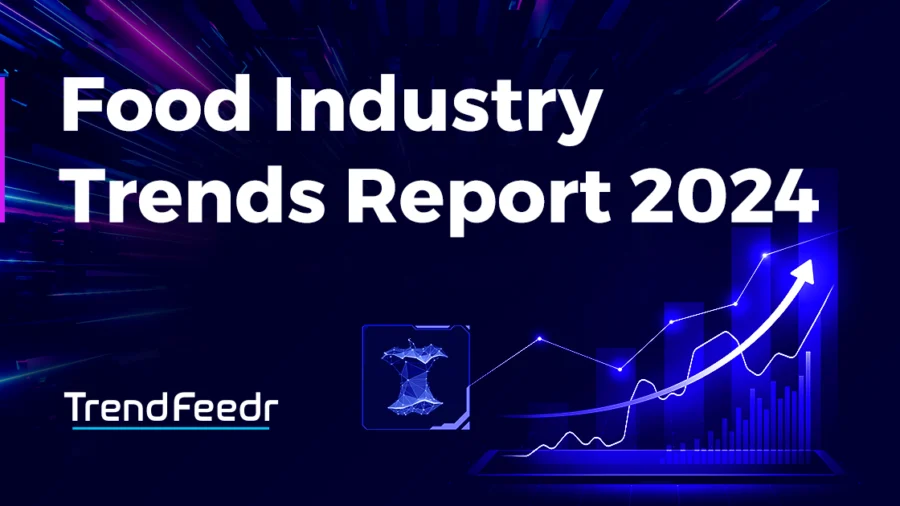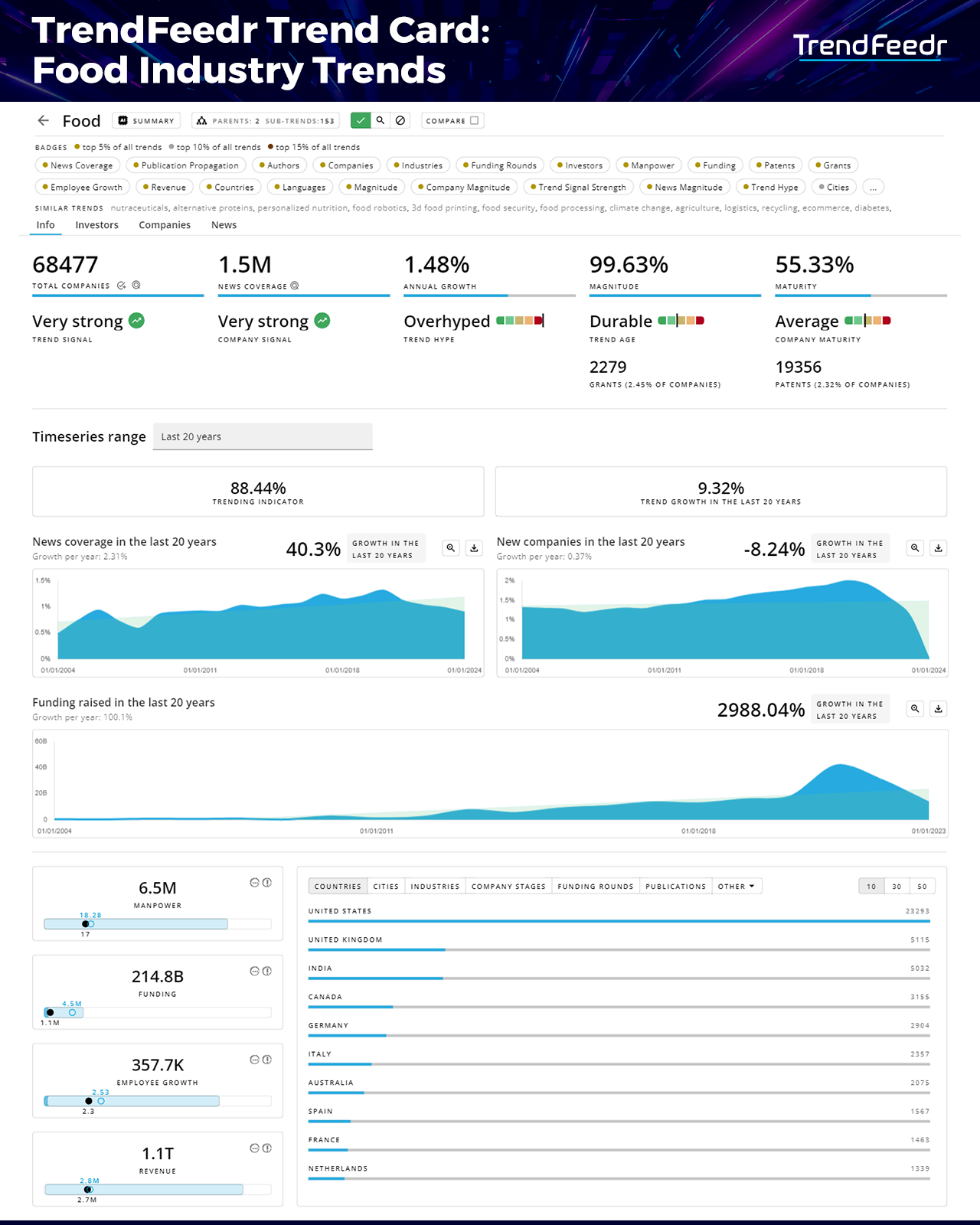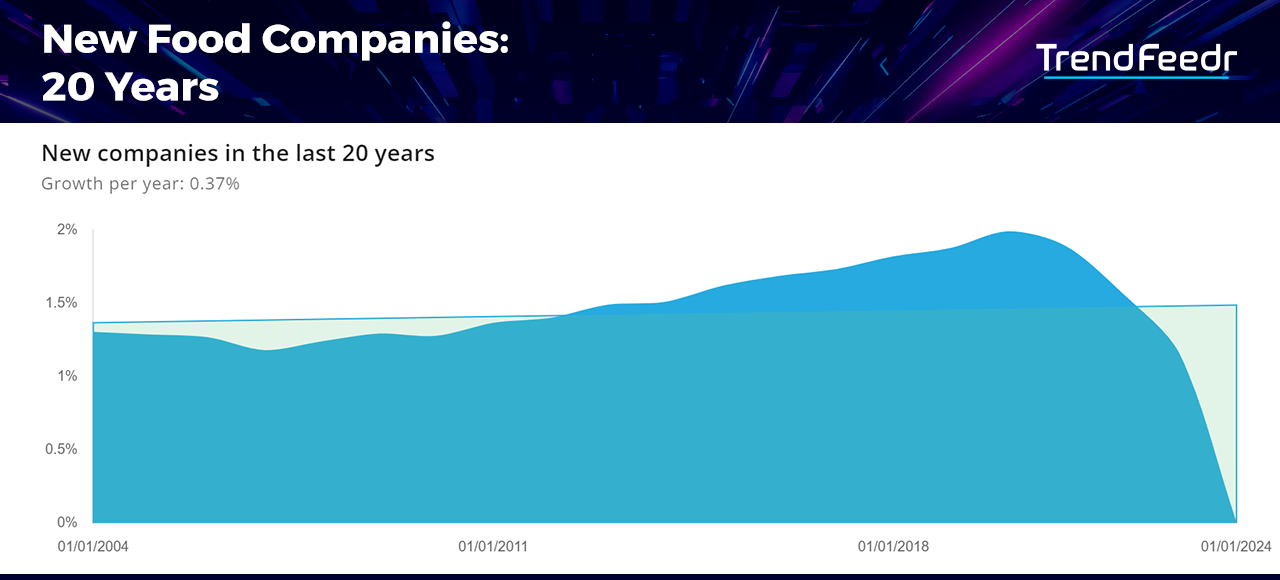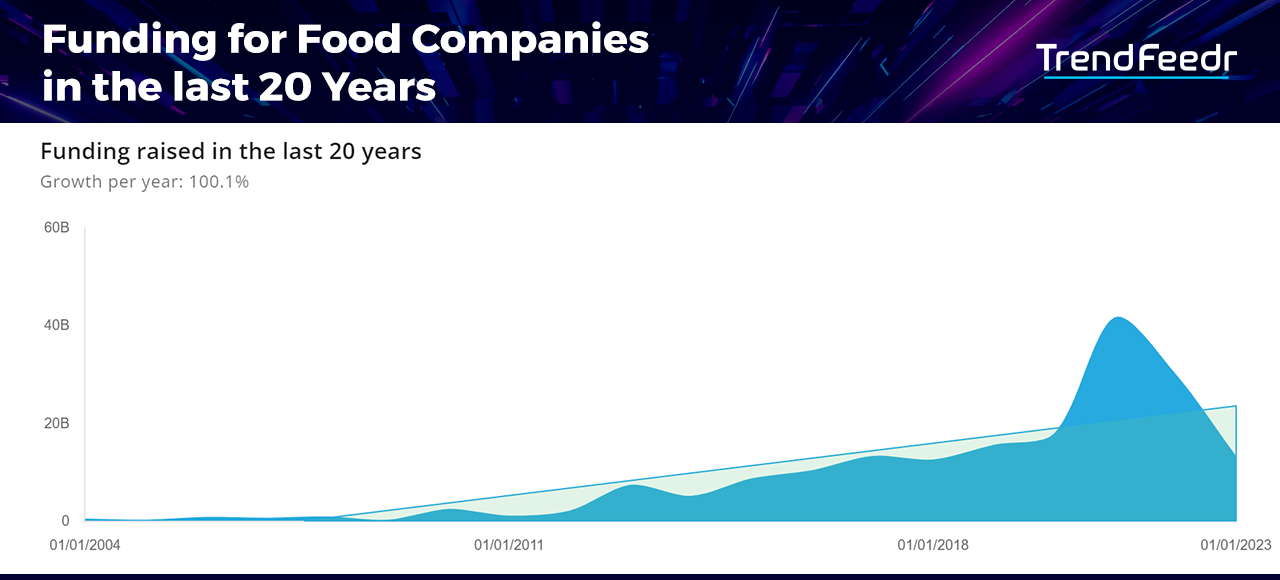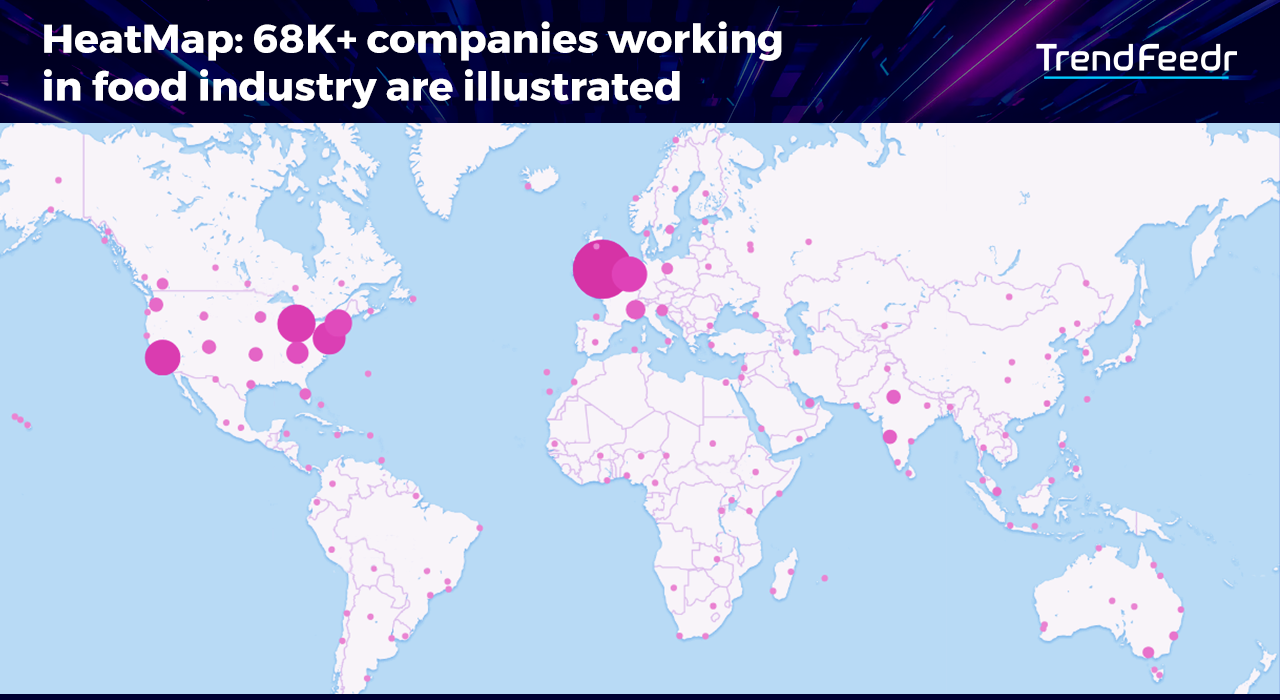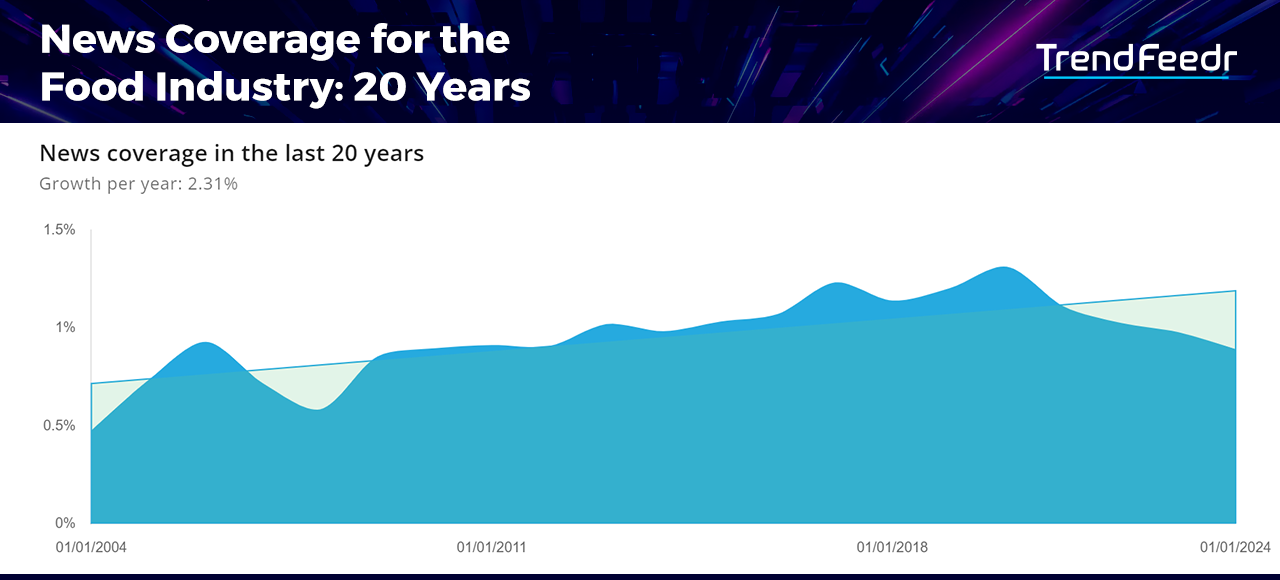The food industry is experiencing transformation due to technological innovation, increasing environmental awareness, and shifting dietary preferences. This food industry trends report examines the dynamic progression of these changes, emphasizing their impact on sustainability and public health. The current trends in the food industry include nutraceuticals, alternative proteins, personalized nutrition, food robotics, and 3D food printing.
The food industry is at the forefront of pioneering developments, particularly in the production of cultured meat and plant-based substitutes. These innovations play a pivotal role in addressing the challenges of sustainable food production. The integration of AI and machine learning into food manufacturing and supply chain optimization also represents a notable advancement. Leveraging AI-driven analytics, the sector is further improving crop yields and minimizing ecological impacts.
The food market trends are compelling. According to a Meticulous Market Research Report, the plant-based food market is projected to experience a compound annual growth rate (CAGR) of 12.4% from 2022 to 2029, culminating in a market value of US$95.52 billion by 2029. Further, this Facts and Factors report predicts that the global AI in the food and beverages market will expand from US$3.07 billion in 2020 to US$29.45 billion by 2026, with an estimated CAGR of approximately 45.70% during the period from 2021 to 2026.
Key Takeaways
- Prominent Trend: According to TrendFeedr, the food industry, with a trend magnitude of 99.63% and a maturity level of 55.33%, is transforming production and supply chain processes.
- Diverse Trend Focus: Food companies are rapidly expanding their focus to encompass trends such as nutraceutical, alternative protein, personalized nutrition, food robotics, and 3D food printing
- Significant Media Attention: The sector’s innovation is underscored by a consistent annual increase of 2.42% in media coverage over the past two decades.
- Robust Organizational and Financial Landscape: Approximately, 68,000 entities are involved in a variety of food-related innovative endeavors. Together, these organizations have garnered an investment capital of approximately US$1.1 trillion.
- Prominent Investors such as Temasek Holdings, Tiger Global Management, and Tencent are investing billions into such trailblazing food initiatives.
- Global Adoption and Leadership: The international arena of food innovation is spearheaded by nations like the United States, the United Kingdom, India, Canada, and Germany. Cities including New York City, London, Melbourne, Mumbai, and Sydney are also becoming pivotal centers for food technology and innovation.
Table of Contents
- Understanding Food Industry Trends
- Food Industry Trend Card
- 5 Key Food Industry Trends
- Emerging Trends and Technologies Disrupting the Food Industry
- 5 Emerging Food Companies
- Food Investment Trends
- Mapping Global Food Companies
- Media Coverage for the Food Industry
- Future of Food Industry
For this detailed analysis of material trends, we use TrendFeedr, our all-in-one trend intelligence platform. TrendFeedr uses advanced algorithms to identify future industry and tech trends. With a focus on trend discovery, clustering, and analysis, the AI-powered platform reviews thousands of trends each week to provide actionable insights.
Among more than 20,000 trends and technologies monitored by TrendFeedr, the food industry has made a significant impact. Here’s why:
- The food industry is among the top 100 trends and also ranks within the top 1% of global trends. This highlights its indispensable role in guaranteeing the availability of safe, nutritious, and ample food on a global scale.
- With a trend maturity of 55.33%, the food industry is distinguished by a dynamic synergy of well-established enterprises and pioneering startups driving its ongoing development and growth.
- The sector is instrumental in nourishing the growing world population, striking a harmonious balance between meeting human nutritional demands and ecological preservation.
In this food industry trends report, let’s explore performance, investment, regional impact, and future outlook.
Understanding Food Industry Trends
Let’s delve into the trends and technologies in the food industry that are reshaping productivity, ecological responsibility, and consumer engagement.
What are the trends in the food industry?
The food industry is witnessing a notable transition towards plant-based diets and alternative proteins, a movement propelled by health, ethical, and environmental considerations. Innovations are characterizing this shift, rendering plant-based offerings more varied, palatable, and nutritionally rich. Concurrently, the trend of personalized nutrition customizes dietary recommendations based on individual health data, lifestyle choices, and personal preferences. This reflects a growing consumer desire for tailored health and wellness strategies.
In parallel, sustainable practices are gaining traction within the industry, with concerted efforts to diminish environmental impact. This encompasses sustainable ingredients procurement, food waste reduction, and the adoption of environmentally friendly packaging. Moreover, there is an escalating demand for functional and nutraceutical foods that confer specific health advantages beyond nutrition, such as immune enhancement or gut health improvement. This is often achieved through fortification with vitamins, minerals, probiotics, and other health-promoting substances.
Additionally, food traceability and transparency are becoming increasingly important to consumers showing an interest in understanding the provenance and journey of their food. This trend is driving the demand for clean labeling, traceability of ingredients, and ethically sourced products, underscoring a shift towards greater accountability and openness.
What technologies are used in the food industry?
The integration of AI and machine learning in the food industry is streamlining supply chains and refining consumer preference predictions. Complementing these technologies, blockchain is enhancing the transparency and traceability of the food supply chain, empowering consumers with the ability to trace their food items.
Simultaneously, 3D food printing is enabling the crafting of bespoke and complex food designs, with notable adoption in the confectionery and culinary arts domains. Robotics and automation are also making significant inroads, increasingly deployed for monotonous and labor-intensive tasks across food production, packaging, and service sectors. It improves operational efficiency and precision. Further, the Internet of Things (IoT) is revolutionizing the supply chain traceability, facilitating food safety and accountability.
Food Industry Trend Card: The Most Recent Developments in the Food Landscape
Our Food Industry Trend Card offers an insightful summary of the dynamic forces shaping the food sector’s landscape.
Looking for all trends related to the food industry?
- Sector Overview: The food industry, comprising 68,477 entities, stands as a cornerstone of the global economy, encompassing an extensive range of operations from food processing to cutting-edge innovation within food-centric sectors.
- Trend Analysis: Exhibiting a trend magnitude of 99.63%, the food industry boasts an almost ubiquitous market presence. With a trend maturity of 55.33%, it also demonstrates a solid foundation with ample opportunities for further growth and inventive breakthroughs.
- Media Attention: With a 40.3% increase in news coverage over the last 20 years, the food industry continues to captivate significant media interest, as evidenced by the sheer volume of related articles and publications.
- Trend Growth: The sector has experienced a 9.32% increase in trend growth over the last 20 years.
- Financial Health and Investment: The food industry has garnered US$214.8 billion in total investments, reflecting its allure to financiers.
- Manpower and Employment Trends: With a workforce numbering 6.5 million, the food industry is a significant employment generator. The aggregate employee augmentation of 357.7K suggests that the industry continues to be a vital source of job creation.
- Revenue Generation: As a pivotal economic contributor, the industry’s total revenue is estimated at US$1.1 trillion. This highlights the industry’s critical role in the international economy and its influence over a wide array of sectors.
- Geographical Footprint: The United States, the United Kingdom, and India emerge as frontrunners in the food industry, serving as principal markets and epicenters of innovation.
Key Food Trends & Firmographic Insights
The food sector employs 6.5 million individuals globally, marking its pivotal role in employment. An average food company employs approximately 123 individuals, showcasing a robust mix of small, medium, and large enterprises that contribute to the sector’s diversity. Notably, the median company size is 17 employees, indicating the prevalence of smaller companies that are integral to the industry’s innovative drive.
Annually, the food industry sees a remarkable workforce increase of 357.7K, signifying a dynamic and burgeoning field. On average, companies experience an annual growth of 8 employees, reflecting the industry’s vitality and potential for ongoing expansion. The median annual growth rate of 2 employees per company also suggests prudent scaling within a competitive and progressive market.
Let’s delve deeper into the five emerging trends in the food industry. We will examine the number of food companies engaged, the aggregate investment, and the workforce participation in each of these trends.
1. Nutraceuticals
- The nutraceutical movement merges cutting-edge biotechnology with nutritional science to produce foods that enhance health beyond traditional nutritional values.
- With 6,290 active organizations, the trend has attracted significant investments totaling US$11 billion.
- A robust workforce of 375,000 is dedicated to advancing and distributing health-promoting products.
2. Alternative Proteins
- The alternative protein trend utilizes innovative bioprocessing to produce sustainable protein sources.
- This trend comprises 1,234 pioneering organizations, backed by a remarkable US$10 billion in funding.
- A workforce of 75,100 is committed to research, production, and the introduction of these innovative protein alternatives.
3. Personalized Nutrition
- Personalized nutrition leverages data analytics, biotechnology, and genetic profiling to create customized dietary plans.
- This segment has garnered the interest of 1,024 organizations, with a collective funding of US$2.2 billion.
- A workforce of 33,700 professionals is at the forefront of devising tailored nutritional solutions, utilizing technology to optimize health.
4. 3D Food Printing
- 3D printing in the food industry incorporates digital technology and material science to create edible products in intricate shapes and structures.
- This trend involves 124 organizations and has secured US$122 million in funding.
- A skilled workforce of 2,040 is exploring the capabilities of 3D printing in revolutionizing food production and presentation.
5. Food Robotics
- Food robotics incorporates AI and precision technologies to improve food processing and service efficiency.
- With 117 organizations invested in this area, the sector has received substantial funding of $839.5 million.
- A workforce of 2,209 professionals is driving this technological advancement, applying robotic solutions in various food industry operations.
How Do Emerging Trends & Technologies Disrupt the Food Industry?
The food industry is undergoing a transformative phase, with emerging trends and technological innovations reshaping the processing, distribution, and consumption of food. Let’s explore these significant developments:
1. Nutraceuticals
Nutraceuticals cater to individual health requirements and dietary inclinations. This sector includes dietary supplements, herbal products, vitamins, and genetically engineered foods. Leveraging genomics and nanotechnology, the industry is moving towards more precise nutrient profiling. AI is also streamlining the research and development process, making it more efficient. Further, collaborative efforts with the healthcare sector are underway to create dietary interventions for chronic conditions.
Startups like BioCorp Nutrition Labs specialize in the production of high-volume nutraceutical supplements, combining proprietary technologies and formulas. The startup provides various supplement types such as capsules, tablets, gummies, powders, and soft gels. Its product categories span various health and wellness areas including bodybuilding, herbal supplements, pet vitamins, probiotics, protein supplements, sports performance, and general vitamins.
2. Alternative Proteins
Focusing on plant-based proteins, cultured meat, and fermented products, alternative proteins reduce the environmental impact of traditional animal farming. Advanced genetic engineering and precision fermentation are key technologies driving this trend. They enable the creation of proteins that mimic the taste and texture of animal-based products. It also explores the use of insects as a protein source, tapping into a highly efficient and sustainable method of protein production.
For instance, Atelier Meats produces structured meats like steaks through advanced cell cultivation technology. By combining cow cells with unique scaffolds, the startup replicates steak textures and flavors. Its approach includes developing cell line banks, expanding cells, and bio-printing them to create the final meat product.
3. Personalized Nutrition
This trend focuses on analyzing individual genetic makeup, lifestyle, and dietary preferences to recommend specific nutrient intakes. Wearable technology and mobile apps play a crucial role in gathering real-time health data and facilitating tailored nutrition advice. Personalized nutrition also incorporates microbiome analysis to offer insights into gut health and its impact on overall well-being. This enhances individual health outcomes by providing nutrition that aligns with each person’s physiological requirements, moving beyond one-size-fits-all dietary guidelines.
Startups like Holifya offer DNA-based tests to create personalized wellness and nutrition plans. The startup’s DNA-based tests analyze genetic profiles to recommend diet, skincare, and sports regimens. Its products include tests for food intolerance, skin care, athletic performance, diet, and comprehensive DNA analysis.
4. 3D Food Printing
3D food printing utilizes food-grade materials like proteins, carbohydrates, and fats as inks in a layer-by-layer manner. The technology is advancing towards printing complex food items, catering to specific dietary needs and aesthetic preferences. It also prints food on demand to reduce food waste and repurposes expiring food into consumable products.
Mycusini, for instance, offers a 3D chocolate printer that features a large touch color display for access to over 1,000 creative templates. The device is user-friendly and allows for quick insertion of 3D choco refills and simple operation. The startup also offers the option to create personalized 3D objects.
5. Food Robotics
Robotic systems in the food industry are employed for tasks like cooking, packaging, and serving, ensuring precision and efficiency. They integrate machine learning algorithms to optimize food preparation, adapting to various cuisines and recipes. Food robotics not only streamlines operations but also innovates in areas like personalized cooking and autonomous food delivery.
For example, RoboChef develops Smart Cookie, a robot that creates personalized, warm-baked gourmet cookies. The startup targets labor reduction and enhanced operation safety in food service, addressing issues like inconsistent quality and rapid scalability.
5 Emerging Food Companies
An analysis of the food industry’s evolution over the last twenty years reveals a consistent emergence of new enterprises. The above time series chart illustrating this progression indicates a steady annual growth rate of 2.42%, demonstrating the sector’s robustness and its ongoing appeal for innovation and entrepreneurial ventures.
5 Promising Food Startups to Watch
Food startups are addressing critical challenges such as nutrition, sustainability, and food security through advanced technologies. They include inventive plant-based solutions, advancements in food technology, sustainable practices, and zero-waste initiatives. We spotlight five notable food startups established in the last five years, emphasizing their contributions to the food industry’s transformation:
- Maia Farms produces CanPro, a non-bitter, fiber-rich mycoprotein that serves as a viable alternative to traditional red meat.
- Enlightened Robotics creates fully automated food trailers, leveraging artificial intelligence and computer vision to streamline food service.
- FoodSquared develops shellfish with a plant-based shrimp alternative.
- Food Analytics provides an AI-powered platform that leverages behavioral science to evaluate, audit, and design food products.
- GoOrderz offers a digitization and management platform that centralizes modernized dining experiences in a single, accessible location.
Food Investment Trends
In terms of financial support, the aggregate investment in food industry trends secures a spot within the top 5% of all 20K+ trends and technologies monitored by TrendFeedr.
The time series analysis of funding within the food industry over the past two decades reveals a notable monthly growth rate of 100.1%. This significant uptrend highlights the robust escalation in investor confidence and the rapidly expanding prospects recognized by investors within the food sector.
A Closer Look at the Financials
According to TrendFeedr‘s data, the total funding in the food industry has reached US$214.8 billion. The peak of this investment surge reached US$1.6 billion, while the mean funding round approximates US$23.2 million. The median funding figure stands at US$1.1 million, illustrating the sector’s fiscal profundity and the diverse magnitude of investment prospects.
In parallel, the food sector boasts a total revenue of US$1.1 trillion, as estimated by TrendFeedr. The apex revenue for an individual entity is US$2 billion, with an average revenue of US$21.3 million and a median of US$2.7 million. These data points underscore the food industry’s substantial economic impact on a global scale.
Delving into funding types, 13.52% of food companies have secured investments, accentuating the sector’s competitive and discerning investment climate. Seed capital serves as the foundation, vital for launching nascent concepts within the food domain. Ascending the financial hierarchy, early-stage venture capital, or Series A funding, becomes imperative for entities on the verge of operational and market expansion.
Furthermore, grants play an instrumental role, with 2,279 awarded to 2.45% of food companies, evidencing robust endorsement for innovative and exploratory endeavors in the food industry. Venture rounds signify a critical juncture for firms seeking substantial funds for growth and innovation, reflective of investor confidence. Conversely, debt financing emerges as a strategic avenue for seasoned companies seeking growth or diversification, epitomizing the food industry’s multifaceted funding landscape.
Prominent Investors in the Food Industry
Temasek Holdings has established a formidable investment footprint in the food industry, channeling funds into 10 companies with a collective investment of US$1.4 billion. Its strategic investments include US$200 million in DoorDash and US$135 million in HealthKart, underscoring its commitment to both food delivery platforms and health-centric dietary solutions.
Tiger Global Management stands as a significant investor, allocating US$1.2 billion across 19 companies. Its substantial investments of US$235 million in NotCo and US$225 million in Meicai signal its trust in the food technology landscape.
Tencent has curated a portfolio encompassing 10 companies within the food sector, with total investments amounting to US$1.1 billion. Its notable contributions of US$146 million to Xingsheng Youxuan and US$100 million to Flipdish accentuate the company’s vested interest in the flourishing online food marketplace.
The public sector has shown vigorous investment activity, with 135 companies drawing an impressive US$4 billion in total funding. Collins Foods leads this investment thrust with US$216.7 million, followed by Ligao Food‘s US$183.5 million. This reflects a keen interest in well-established food service and production entities.
The investment community’s engagement in food trends is substantial, with the variety and scale of investors placing them in the top 5% of all trends.
Mapping Food Companies Around the Globe
Our heatmap provides a comprehensive overview of the global food industry, showcasing an estimated 68,000 companies at the forefront of innovation in the sector.
Interested to explore all 68K+ food companies?
The United States asserts its dominance in the food industry, not merely in the number of businesses but also in its innovative approaches and substantial market presence. The United Kingdom and Germany closely follow, exhibiting impressive advancements, particularly in food technology and sustainable practices. India, with its extensive consumer market and swiftly evolving food industry, has experienced a surge in the number of food companies, with a focus on organic and health-centric products. Canada has also achieved notable progress, especially in food safety and agricultural technology, establishing itself as an influential participant in the international food arena.
Exploring the urban epicenters, New York City, with a dense cluster of food companies from nascent startups to established multinationals, mirrors its diverse and cosmopolitan demographic. London, renowned for its culinary legacy and progressive food regulations, continues to be a fertile ground for a broad spectrum of food businesses. Further, Melbourne has witnessed a rise in cutting-edge food startups, especially those dedicated to sustainability and health-conscious offerings. Mumbai reflects the growth within its food sector, with an uptick in both conventional and contemporary food enterprises. Lastly, Sydney has observed a modest growth in food companies, with a discernible focus on organic and locally sourced produce.
Media Coverage for Food Industry Sees a Yearly Uptick of 2.31% Over the Last 20 Years
The time series chart delineating the evolution of media attention towards the food industry over the preceding two decades indicates a stable yearly growth rate of 2.31%. This progression emphasizes the enduring and escalating focus on the food industry’s trends, breakthroughs, and progressions.
Moreover, the food industry distinguishes itself within the media domain, achieving publication growth that ranks it among the top 5% of all trending topics. From 2005 to 2024, a remarkable tally of 1,456,403 articles on the food industry has been recorded, securing the subject’s position at the top of media focus.
How will the Food Industry change in the Future?
Given the current trajectory and the available data on food industry trends, we can project several key insights and predictions for the future of this dynamic sector. Here’s the food industry outlook:
1. Embracing Sustainability in the Food Industry
The food sector is progressively pivoting towards sustainable practices to mitigate environmental impacts and meet the consumer’s inclination for eco-conscious products. Efforts include diminishing carbon footprints in production, transitioning to renewable energy, and deploying water conservation technologies.
Packaging innovation is also evident, with a move to biodegradable and recyclable options. Moreover, enterprises are striving to curtail food wastage across the supply chain, from manufacturing to distribution. They are also advocating for agricultural methods that safeguard biodiversity and soil vitality.
2. Improving Food Supply Chains
Technological advancements are facilitating the refinement and transparency of food supply chains. The incorporation of IoT devices, AI, and blockchain enables real-time tracking and management of food items, promoting freshness and minimizing decay.
Such enhancements also encompass improved demand forecasting to avert excess production, optimizing transport routes for expedited delivery and refined inventory control. These technological strides improve operational efficiency and also enhance sustainability by reducing waste and shrinking logistics carbon footprint.
3. Growing Urban Farming and Local Food Sourcing
Urban agriculture is gaining traction as a viable approach to sustainably nourish the growing urban population. Innovative cultivation methods such as vertical farming, rooftop gardens, and hydroponics allow for hyper-local crop production.
As a result, local sourcing will become a major trend in the food sector. This diminishes the necessity for extensive transport, thereby lowering carbon emissions and guaranteeing fresher produce. Additionally, urban agriculture fosters community involvement and contributes to urban food security by enhancing the accessibility of fresh produce.
4. Adapting to Changing Consumer Tastes in Food
A trend toward health-aware, ethically-produced, and culturally varied food options is becoming increasingly apparent. Consumers are gravitating towards organic, non-GMO products devoid of synthetic additives. There is also an increasing interest in international cuisines and culinary fusions, mirroring the expanding cultural diversity and exploratory taste preferences.
Ethical considerations, including animal welfare and equitable trade practices, are shaping buying behaviors. At the same time, people are increasingly looking for easy-to-make food options because of their busy lives. This is why meal kits, pre-made meals, and snacks are becoming more popular. This paradigm shift in consumer predilections is compelling food producers and retailers to modify their product assortments to align with these changing demands.
Food Industry Trends: Navigating the Path of Sustainable and Innovative Food Solutions
As we wrap up our food industry trends report, it is clear that we are moving through a rapidly changing landscape. The pace of discoveries is fast, and the range of possibilities seems endless. Keeping up with these changing trends is very important. It allows you to anticipate changes, take advantage of new opportunities, and stay ahead in a field that is shaping the future. But how do you do that?
Connect with food industry enthusiasts, industry leaders, and innovative creators; their insights can provide valuable perspectives and open up opportunities for collaboration. Dive into food market research reports, attend food industry-focused seminars and conferences, and participate in online food industry communities. Also, use trend-tracking tools, like TrendFeedr, that meticulously track up to 153 food industry sub-trends, offering a comprehensive view of the evolving food industry landscape.

